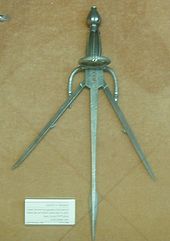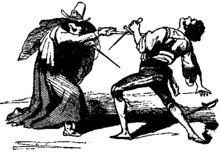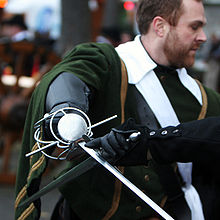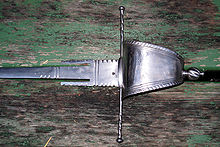- Parrying dagger
-
The parrying dagger is a category of small hand-held weapons from the European late Middle Ages and early Renaissance. These weapons were used as off-hand weapons in conjunction with a single-handed sword. As the name implies they were designed to parry, or defend, more effectively than a simple dagger form, typically incorporating a wider guard, and often some other defensive features to better protect the hand, as well. The main-gauche (French for "left hand", pronounced: [mɛ̃ ɡoʃ]) is used mainly to assist in parrying incoming thrusts, while the dominant hand wields a rapier or similar longer weapon intended for one-handed use. It may also be used for attack if an opportunity arises. The general category includes two more specific kinds of weapon: sword breakers and trident daggers[1].
The use of an off-hand weapon gradually fell out of favor as sword fighting evolved into the modern sport of fencing. The use of progressively lighter primary weapons such as the small sword, épée, and foil allowed for greater speed. Under these circumstances the use of just a primary weapon offered improvements in balance as well as a stance that offered a smaller target.
Contents
Swordbreakers
The sword-breaker was a very sturdy dagger that had slots on one side much like the teeth of a comb. The teeth could catch the blade of the opponent's sword and hold it fast, allowing a variety of follow-up techniques. It is uncertain whether "sword breakers" could, in fact, break sword blades as suggested by some scholars,[2] as swords of this era were intended to stand up to substantial forces, well in excess of what could be generated by a fighter's off-hand. Swords are sometimes depicted in Fechtbüchern as withstanding a two-handed attempt to break them (or show off their resilience).[3] Late Renaissance rapiers and smallswords may not be as robust as the cutting swords of earlier times, however, and have indeed been known to break on occasion, so the claim may have more veracity in relation to the typical civilian weapons of this period.
Trident daggers
 Trident dagguer, 16th century, made in Germany. Picture taken at the Château d'Écouen, France.
Trident dagguer, 16th century, made in Germany. Picture taken at the Château d'Écouen, France.
Trident daggers are built so that a portion of the blade on each side springs outwards. This creates a dagger capable of trapping blades more securely and more easily.[4]
Modern usage
An off-hand weapon is rarely used in modern sport competition; in fact, the use of the off hand as a defensive measure is often prohibited by the rules of many sport fighting styles that are common in the Western world today. One exception is kendo where the use of two shinai of different size is allowed but uncommon; this style is known as nito-ryu. Several other fighting styles not only incorporate but even promote off hand weapons, for example the Filipino style eskrima. Simultaneous use of two weapons is also frequently featured in fiction, particularly in video games, literature and other media from the fantasy genre, where it is commonly dubbed "dual wield". The Society for Creative Anachronism terms heavy weapon fighting with two weapons, usually two swords, as "Florentine style," while the SCA's rapier combat makes use of various forms of off-hand device, including parrying daggers, batons, cloaks, and a second sword, which in fencing is termed "case of rapier."
See also
- Companion weapon
- Dagger
- Eskrima
- Sai
- Hyoho Niten Ichi-ryu
- Katara (कटार)
- Jitte
- List of daggers
- Buckler
Notes
- ^ http://www.myarmoury.com/feature_euroedge.html#parrying Forms of European Edged Weaponry
- ^ http://users.wpi.edu/~jforgeng/17cIQP/weapon.html Arms and Armor in the Age of the Musketeer Weapons of the 17th Century
- ^ http://www.thearma.org/essays/quality-and-build.html Fight-Book Clues to Quality and Build of Knightly Weaponry
- ^ http://www.myarmoury.com/feature_spot_combo.html Spotlight: Combination Weapons
External links
- "Forms of European Edged Weaponry". www.myArmoury.com. 2003. http://www.myarmoury.com/feature_euroedge.html#parrying. Retrieved 2007-11-24.
- Jeffrey Hull (2007). "Fight-Book Clues to Quality and Build of Knightly Weaponry". www.thearma.org. http://www.thearma.org/essays/quality-and-build.html. Retrieved 2007-11-24.
- Chad Arnow. "Spotlight: Combination Weapons". www.myArmoury.com. http://www.myarmoury.com/feature_spot_combo.html. Retrieved 2007-11-24.
- [http://web.archive.org/web/20070216170215/http://users.wpi.edu/~jforgeng/17cIQP/weapon.html
- Article about swordbreakers. Foto "Arms and Armour in the Age of the Musketeer"]. Archived from the original on 2007-02-16. http://web.archive.org/web/20070216170215/http://users.wpi.edu/~jforgeng/17cIQP/weapon.html
- Article about swordbreakers. Foto. Retrieved 2007-05-13.
Categories:- Blade weapons
- Daggers
- Mêlée weapons
Wikimedia Foundation. 2010.



